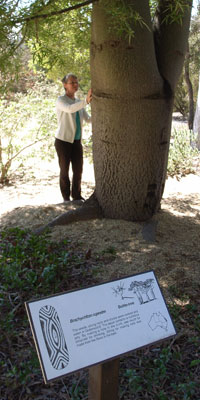
Aboriginal Plant Use Trail
A walk previously available at the Gardens, the first Aboriginal Plant Use Trail highlighted a selection of plants and some of the ways that these have been used by Aboriginal people in different parts of Australia. Similar plants may have been used for the same purposes by many groups in different areas, depending on local availability.
A newer version of an Aboriginal Plant Use walk is now available. This page is retained as an archive of the previous trail but the information presented here (including plant names) will not be updated.
Aboriginal Plant Use
Introduction by Beth Gott
Australian Aboriginal people have lived in Australia for at least 40,000 years, and in all those long generations the land provided them with everything they needed for a healthy life. They also learned to manage their country in such ways that its resources renewed themselves and were not used up.
How did they do this? To quote Edward Curr, an early settler, they 'tilled their ground and cultivated their pastures with fire'. By controlled burning, they kept the bush open and allowed the growth of new seedlings in the ash-bed. Aboriginal people in Arnhem Land still do this. Many Australian plants will re-grow quickly after a fire; indeed some plants such as the grass-tree (Xanthorrhoea spp.) flower more prolifically after fire.
At least half of the food eaten by Aboriginal people came from plants, and it was the task of the women to collect them. Just as we eat root vegetables, greens, fruits and seeds, so did the Aboriginal people. Fruits, seeds and greens were only available during their appropriate seasons, but roots could usually be dug up all the year round, because the earth acted as a natural storage cupboard. Important foods were replanted. The regular digging-over of the soil, and the thinning out of clumps by collection of plants, together with burning to provide fertiliser, is not very different from what we do in our own gardens, and the whole country was in a way an Aboriginal garden.
The particular plants which were eaten varied, of course, in different parts of Australia; in this guide it is only possible to mention a few of them.
In Arnhem Land, north Queensland and the Kimberleys, there are many tropical trees which bear fruits and seeds, such as native figs (Ficus spp.), lilly-pillies (Acmena, Eugenia and Syzygium spp.) and Macadamia nuts. One fruit, the Green Plum (Buchanania obovata) is enormously rich in Vitamin C. True yams (Dioscorea spp.) were important root vegetables, although one of them, Dioscorea bulbifera, is called the 'cheeky yam', because it will make you sick unless it is grated up and thoroughly washed in water before it is used. Another important root was the wild Water-chestnut or Spike-rush, (Eleocharis dulcis).
In central Australia, where water is scarce, the plants are spread thinly over the land. Here the Aboriginal peopl relied more on the seeds of native grasses, and wattles such as Mulga (Acacia aneura), Wiry Wattle (Acacia coriacea), and even seed of the Coolabah tree (Eucalyptus microtheca). There were also fruits of the various 'bush tomatoes' (Solanum spp.), Quandong or Native Peach (Santalum acuminatum), Native Plum (Santalum lanceolatum) and Desert Fig (Ficus platypoda). Roots included Desert Yam (Ipomoea costata), which can have a tuber the size of a man's head, and Nalgoo (Cyperus bulbosus), a sort of nut-grass, often called 'bush onion'.
In the southern parts of Australia, roots (applying that word to all underground plant parts) were the most important foods. Like the Maoris of New Zealand, the Australians used the long roots (rhizomes) of Bracken Fern, (Pteridium esculentum) from which they chewed or beat out a sticky starch. There are many native lilies with small tuberous roots which were collected for food Early Nancy (Wurmbea dioica), Chocolate Lily (Dichopogon strictus) and Milkmaids (Burchardia umbellata) for example. Murnong or Yam-daisy (Microseris lanceolata) was a plentiful and favourite food. Along the Murray-Darling river system, cumbungi or Bulrush (Typha spp.) provided much nourishment, as did Water Ribbons (Triglochin procera), and Marsh Club-rush (Bolboschoenus medianus), which has hard walnut-sized tubers.
In south-western Australia roots were also the most important food, especially Warran Yam (Dioscorea hastifolia).
Most southern fruits were small, including those of the Heath Family (Epacridaceae) and Dillon Bush (Nitraria billardieri), which bears heavy crops of red fruits which were much liked.
 Plants were used for many other things besides food. The long leaves of sedges, rushes and lilies were collected to make baskets and mats, and soaked and beaten to free the fibres to make string. The bark of trees made buckets, dishes and shields; River Red-gum bark was particularly good for making canoes, and old scarred 'canoe trees' can still be seen. Some rice-flower shrubs (Pimelea spp.) have such strong fibres on the outside of the stem that they have been called 'bushman's bootlace', and were used by the Aboriginal people to make fine nets in which to collect Bogong Moths to eat.
Plants were used for many other things besides food. The long leaves of sedges, rushes and lilies were collected to make baskets and mats, and soaked and beaten to free the fibres to make string. The bark of trees made buckets, dishes and shields; River Red-gum bark was particularly good for making canoes, and old scarred 'canoe trees' can still be seen. Some rice-flower shrubs (Pimelea spp.) have such strong fibres on the outside of the stem that they have been called 'bushman's bootlace', and were used by the Aboriginal people to make fine nets in which to collect Bogong Moths to eat.
Medicines also came from plants native mints (Mentha spp.) were remedies for coughs and colds, and the gum from gum-trees, which is rich in tannin,was used for burns.
The plants in this guide are listed by their botanical names, because common names often vary in different parts of Australia. Aboriginal people spoke many languages, and so they also have many different names for plants. Some Aboriginal names have become our common names Geebung, for instance, for Persoonia species.
Some of the plants on this trail have not yet reached the stage at which they would have been utilised by the Aboriginal people. Many of the food-producing plants bear their fruits for short periods of the year only. Thus the part of the plant that was used will not always be evident on the specimens presented here.
The references used to compile this folder are filed in the office of the Australian National Botanic Gardens.
The following books can be consulted for more information:
Gott, B., 1991 Victorian Koorie Plants: some plants used by Victorian Koories for food, fibre, medicines and implements. Yangennanock Women's Group, Aboriginal Keeping Place, Hamilton, Victoria.
Issacs, J., 1987 Bush Food. Weldons, Sydney.
Low, T., 1988 Wild Food Plants of Australia. Angus and Robertson, Sydney.
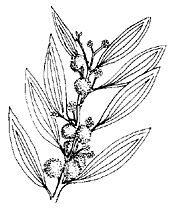 Acacia melanoxylon (Blackwood)
Acacia melanoxylon (Blackwood)
The wood of Blackwood, being very hard and close-grained, was used in Victoria for spear-throwers and shields; the bark was infused in water to bathe rheumatic joints, and the inner bark was used to make string.
Distribution: NSW, Qld, SA, Tas, Vic.
There are over 1,000 different wattle species in Australia, and many of them were used by the Aboriginal people. In many areas wattle gum was an important food as well as a cement. Wattle seed is high in protein and carbohydrate and was eaten both green and dry in the arid areas. The Tasmanians ate the green seed and pods of Coast Wattle, Acacia sophorae, and Varnish Wattle, Acacia verniciflua, and wattle blossom was hung in their huts to promote sleep.
 Alocasia macrorrhizos (Cunjevoi)
Alocasia macrorrhizos (Cunjevoi)
The swollen stems are starchy and fibrous, but are POISONOUS if eaten raw, causing the mouth and throat to swell, sometimes fatally. The Queensland Aboriginal peopl repeatedly roasted and pounded the plant to remove the poison. Cunjevoi is an Aboriginal name from southern Queensland.
NSW, QLD.
 Araucaria bidwillii (Bunya Pine)
Araucaria bidwillii (Bunya Pine)
When this tree is mature it will bear large green cones, and inside each scale of the cone will be found a hard-shelled nut about 5cm long. These nuts were such a popular food that tribes came from hundreds of kilometres around the Bunya Mountains in southern Queensland to feast on them.
Particular trees were considered to be the property of certain Aboriginal families, but everyone was invited to share the delicious nuts, which are not unlike chestnuts when roasted in the fire.
Although found only in Queensland, Bunya Pines have been planted in the southern States, and the nuts may sometimes be bought in Sydney markets. They can be boiled or roasted.
QLD.
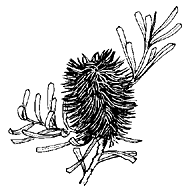 Banksia spp. (Banksias)
Banksia spp. (Banksias)
The flower-cones were soaked in water in bark or wooden containers to extract the nectar to make sweet drinks. Early settlers called banksias 'honeysuckles'. Some banksias, such as the local Silver Banksia, Banksia marginata, retain the dry flowers on the cones, and Victorian Aboriginal people used these as strainers for drinking water.
All Australian States: NSW, QLD, VIC, TAS, SA, NT, WA.
Brachychiton rupestris (Bottle-tree)
The seeds, young roots and shoots were cooked and eaten in Queensland. The wood contains a nutritious jelly. By making a hole in the trunk, sap could be obtained for drinking. String for making nets was made from the fibres in the bark.
QLD.
Callitris spp. (Native Cypress pines)
Aboriginal people on the Murray River made a combined canoe pole and fish spear nearly 4 m long from the wood of the Murray Pine, Callitris preissii, called by them Maroong. The resin was also a cement for fastening barbs to spears.
All Australian States: NSW, QLD, VIC, TAS, SA, NT, WA.
Casuarina and Allocasuarina spp. (She-oaks)
The hard wood of she-oak was much used for making boomerangs, shields and clubs. In Wyrie Swamp, South Australia, archaeologists found a boomerang 10,000 years old, made from she-oak wood. Young shoots were chewed to allay thirst, and young cones were also eaten.
All Australian States: NSW, QLD, VIC, TAS, SA, NT, WA.
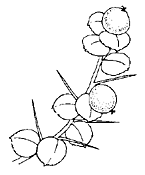 Citriobatus pauciflorus (OrangeThorn)
Citriobatus pauciflorus (OrangeThorn)
The edible fruits are round and yellow, 1-3cm across, with a leathery skin and large seeds.
NSW, QLD.
Dianella spp. (Flax Lilies)
The fibre in the leaf is very strong. A leaf, split and twisted into a cord, has been found in an Aboriginal burial in central Victoria. This and other Flax-lilies were used for baskets in Tasmania. The berries are blue-purple, and may be poisonous. There is no evidence that they were eaten by Aboriginal people.
NSW, QLD, SA, TAS, VIC, WA.
Dicksonia antarctica (Smooth Tree-fern)
The top of the trunk was split open to extract the soft starchy pith. The Tasmanians preferred the Rough Tree-fern, Cyathea australis, because it tasted better than the Smooth Tree-fern. The Smooth Tree-fern is the one which is usually grown in home gardens.
NSW, QLD, TAS, VIC.
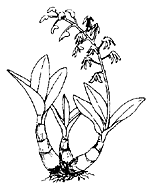 Dendrobium speciosum (Rock or King Orchid)
Dendrobium speciosum (Rock or King Orchid)
The swollen stems were beaten to break up the fibre and then cooked on hot stones.
NSW, QLD.
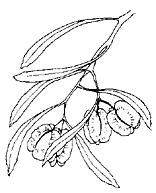 Dodonaea viscosa (Hop-bush)
Dodonaea viscosa (Hop-bush)
In Queensland the juice of the root was applied for toothache and cuts; the chewed leaf and juice was put on stonefish and stingray stings and bound up for 4-5 days.
All Australian States: NSW, QLD, VIC, TAS, SA, NT, WA.
 Doryanthes excelsa (Gymea Lily)
Doryanthes excelsa (Gymea Lily)
The flowering stems grow up to 4 m high, but were cut when young, about 0.5 m long and thicker than a man's arm, and roasted. The roots were also roasted and made into a sort of cake. The name 'GYMEA' comes from the Wodi Wodi tribe of the Illawarra district near Sydney. Flowering summer.
NSW.
Enchylaena tomentosa (Ruby Saltbush)
The tiny red flattened fruits were shaken off the bush and eaten. They have a small black stone inside, which was also eaten.
All mainland States: NSW, QLD, VIC, SA, NT, WA.
Eucalyptus viminalis (Manna Gum)
Where holes have been made by insects in the young branches, sap flows out and dries into hard sugary drops which fall to the ground, hence the name 'manna'. Aboriginal people and early settlers were very fond of it. Other gum-trees may also produce manna for example Eucalyptus mannifera, of which there are numerous specimens in the Gardens. Both these gum trees are native to the Canberra district.
In common with other eucalypts, the wood was used for implements such as shields, and wooden bowls known in Victoria as 'tarnuks'.
NSW, QLD, SA, TAS, VIC.
Eustrephus latifolius (Wombat Berry)
The roots of this climber are edible, and it is highly likely that they were eaten by Aboriginal people. The fruits do not seem to have been eaten.
NSW, QLD, VIC.
 Exocarpos cupressiformis (Cherry Ballart, Native Cherry)
Exocarpos cupressiformis (Cherry Ballart, Native Cherry)
The fruits of the Native Cherries have a succulent base with a hard seed on top. There are several species, but this one is the most common. The wood was used for spearthrowers and for bull-roarers (a musical instrument), and the sap was applied to snakebites. The native cherries are hard to cultivate, because they are parasitic on the roots of other trees. The Aboriginal name 'BALLART' comes from western and central Victoria.
NSW, QLD, SA, TAS, VIC.
Hedycarya angustifolia (Austral Mulberry)
The most important use of this mountain shrub was as straight sticks for fire-drills, which were twirled between the hands while resting on another flat piece of wood, often the dry flowering stalk of the grass-tree. Within two minutes fire could be produced. The sticks were so highly prized that they were traded from tribe to tribe, from the mountains to the Murray River. The fruits resemble a yellow mulberry, but are not edible.
NSW, QLD, TAS, VIC.
Indigofera australis (Austral Indigo)
One of the many different plants that were crushed and put into pools to kill or stun fish so that they could be easily caught. Among other plants used in different parts of Australia were the leaves and bark of several wattles and gum-trees, and the Wild Indigo, Tephrosia purpurea.
NSW, QLD, SA, TAS, VIC, WA.
Lambertia formosa (Mountain Devil)
The copious nectar of this plant sometimes flows down the twigs. The flowers were sucked. Although there is one report of nausea and headache after consuming a large amount, the nectar appears to contain no toxic substance.
NSW.
Livistona australis (Cabbage Palm)
The heart of the palm was eaten in the north of Australia, but although it can be found as far south as eastern Victoria, early observers say it was not eaten there before European settlement.
NSW, QLD, VIC.
Lomandra longifolia (Spiny-headed Mat-rush)
The long smooth leaves were used to make baskets and mats. By beating and soaking the leaves, fibre was separated to make string for net-bags. The flowers provided nectar. This plant is still used at Lake Tyers, Victoria, to make traditional baskets, and at Lake Condah to make eel-traps.
NSW, QLD, SA, TAS, VIC.
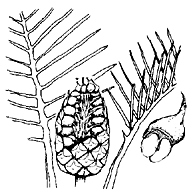 Macrozamia spp. (Burrawangs)
Macrozamia spp. (Burrawangs)
The seeds of these and other cycads are borne in a large cone and have an orange outer coat. They are POISONOUS, but the Aboriginal people knew how to treat them to remove the poison, and so take advantage of the large amount of food provided by a single plant. One of the ways was to cook the seed, break it up, and then soak it for up to three weeks in running water. In Western Australia, only the outer red part was eaten, after treatment by washing and burying.
NSW, NT, QLD, WA.
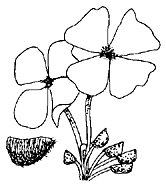 Marsilea drummondii (Nardoo)
Marsilea drummondii (Nardoo)
An unusual fern, which grows in shallow seasonal waters. When the water dried up, the hard spore-cases were collected. They were broken up on grindstones, and the spores were separated from the outer cases. The spores swell when moistened, and were made into damper. Although used in drier areas such as Cooper's Creek, Nardoo is said to have been largely a standby food when other things were in short supply. The explorers Burke and Wills found that a diet of Nardoo alone was not enough to sustain life.
NSW, NT, QLD, SA, VIC.
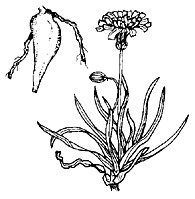 Microseris lanceolata (Murnong or Yam-daisy)
Microseris lanceolata (Murnong or Yam-daisy)
This small perennial plant was the favourite food of the Aboriginal people of central and western Victoria, and was also eaten in South Australia and New South Wales. It has a radish-shaped tuber, which is renewed each year. In the spring the plant forms a yellow flower-head like a dandelion, and in the summer the leaves die off and the tuber becomes dormant. The tubers were cooked in baskets in an earth oven, producing a dark sweet juice which was much liked. Once a common plant, Murnong became scarce due to grazing by sheep.
NSW, SA, TAS, VIC, WA.
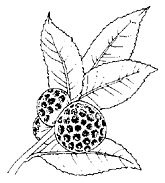 Nothofagus moorei (Antarctic Beech)
Nothofagus moorei (Antarctic Beech)
An orange fungus, Cyttaria septentrionalis about the size of a golf-ball may grow on this tree, and was eaten raw. Other species of Nothofagus in Tasmania and Victoria bear a related fungus, which was also eaten.
NSW, QLD.
 Persoonia pinifolia (Geebung)
Persoonia pinifolia (Geebung)
Inside the sweet pulp, the edible fruit has a very hard stone, which was discarded. Other persoonias were also eaten. The New South Wales Aboriginal name 'GEEBUNG' has been given to all Persoonia species.
NSW.
Phragmites australis (Common Reed)
The tall bamboo-like stems were highly prized for spears, and were also cut into short lengths to make necklaces, or to stick through the septum of the nose as an ornament. The leaves were used to make bags and baskets.
All Australian States: NSW, QLD, VIC, TAS, SA, NT, WA.
Podocarpus elatus (Brown Pine)
The seed is borne on a purple-black fleshy stalk, which was eaten. It is sweet but mucilaginous.
NSW, QLD.
Rhagodia spinescens (Thorny Saltbush)
The Aranda tribe in central Australia used the fruits to make a red paint for the face.
NSW, NT, QLD, SA, VIC.
Rubus hillii (Native Raspberry)
There are several native raspberries, all of which were eaten. This one is found in rainforest. The Mountain Raspberry, Rubus gunnianus, is found only on Tasmanian mountains, while the Small-leaf Bramble, Rubus parvifolius, is widespread in drier forests.
NSW, QLD, VIC.
Solanum laciniatum (Kangaroo Apple)
One of the Kangaroo Apples of eastern Australia, the egg-shaped orange fruits were eaten only when they were ripe enough to fall from the bush. In Tasmania, they were picked earlier, and buried in sand-heaps to ripen. They can be POISONOUS if eaten unripe. The fruits contain hard small stones as well as seeds. In central Australia, many other Solanum species are important foods, and are known as bush tomatoes'.
NSW, QLD, SA, TAS, VIC, WA.
Sollya heterophylla (Bluebell Creeper)
The dark bluish fruits were eaten in Western Australia.
WA.
Tasmannia insipida (Pepper Tree)
The flesh of the purple-black fruit is edible, but the few black seeds are very peppery.
NSW, QLD.
Typha spp. (Cumbungi or Bulrushes)
A multi-purpose plant, the 'staff of life' along the Murray-Darling river system and in south-western Australia. The underground horizontal 'roots' (rhizomes) were steamed in an earth oven, the outer layer was stripped off, and the starchy fibrous inner part was tied in a simple knot. This was then chewed to remove the starch, which tastes like potato. The remaining fibre was dried, soaked, scraped with mussel shells, and then rolled on the thigh to give very strong string for making large nets which were used to catch ducks and fish. Finer string was made from the leaves. The young shoots which appear in early summer were eaten raw. 'CUMBUNGI' is a name from the middle Murray River area.
All Australian States: NSW, QLD, VIC, TAS, SA, NT, WA.
Xanthorrhoea spp. (Grass Trees)
The bases of the leaves are sweet and nutty, and the heart of the stem was also eaten. Nectar was collected from the tall spike of flowers with a sponge made of stringybark. The dry flower-stems of smaller species were used for spears, and those of this larger species were used to make fire, as well as containing large edible grubs. at the base of the plant globules of a hard waterproof resin were collected, which served as a cement to fasten barbs in spears or stone axes to handles. The tough leaves were used as knives to cut meat. This is one of the native plants which flowers in response to fire.
All Australian States: NSW, QLD, VIC, TAS, SA, NT, WA.
![Director of National Parks [logo]](../../../../images/dnp_90px.gif)





